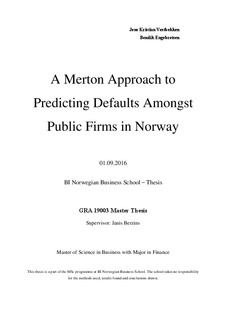| dc.description.abstract | The primary objective of this thesis is to investigate how well Merton’s corporate debt model performs in predicting defaults amongst public firms in Norway. The study concludes that the model performs adequately in predicting defaults amongst public firms in in this market. However, the application of the model is dependent on historical market values of equity, making it unable to estimate default probabilities for young public firms.
In this thesis, Merton’s corporate debt model is used by applying the generated distance to default as the covariate in the logit model to estimate the probability of default. Three analyses are conducted to validate the model’s performance: regression analysis, discriminatory power analysis and a calibration analysis of the probability of default quantification. Two different sets of historical defaults are used, each with its own definition of default. The first dataset contains data from The Brønnøysund Register Centre on historical bankruptcies from 1996-2015. The second dataset is based on Stamdata’s registry of bond issuers’ financial failures from 2007-2015.
The model is tested with different types of equity volatility. The logistic regression analysis concludes that while no single version of the model exhibits exceptionally high explanatory power, models based on equity volatility with an estimation window of 90 days seem to be adequate candidates in the application of the model. Moreover, the study shows that winsorizing equity returns does not add much explanatory power, while a logarithmic functional form in the logit model yields higher fit.The discriminatory analysis finds that the model’s ability to discriminate between defaulting and non-defaulting firms exceeds that of pure statistical models, achieving accuracy levels on par with previous studies. The calibration analysis concludes that the model has low risk of underestimating the true credit risk when predicting bankruptcies. However, the model exhibits some risk of underestimation in distressed economies when predicting financial failures. Moreover, the analysis concludes that the logarithmic functional form in the logit model underestimate the true credit risk. | nb_NO |
